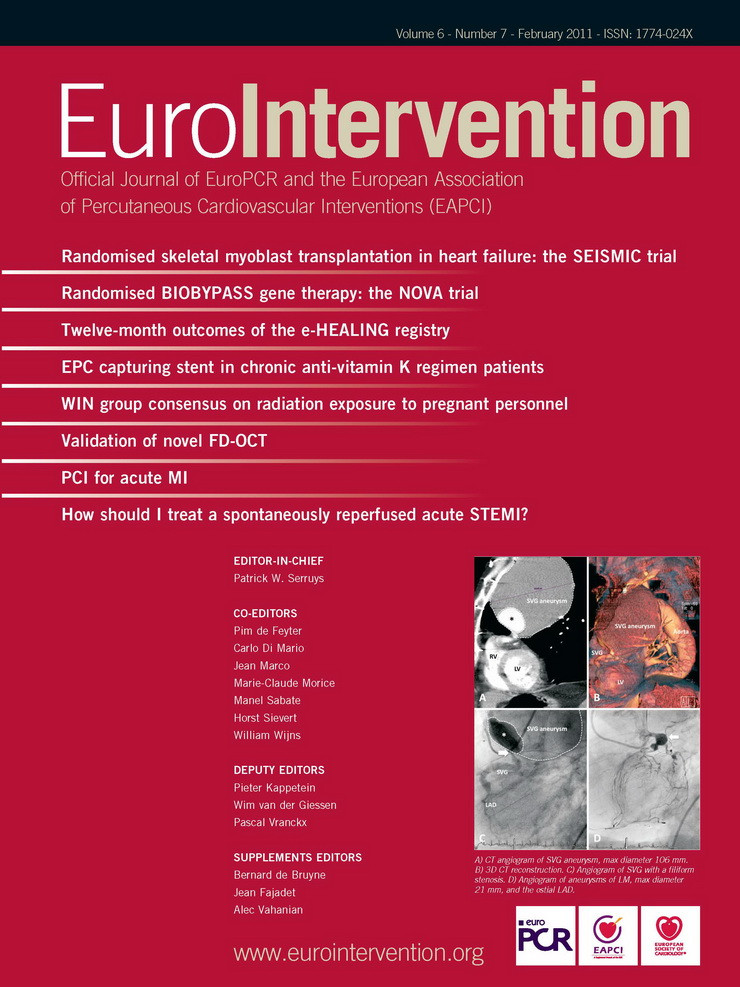Dear colleagues,
Like yourselves, we are struck by how quickly time passes, it was only yesterday that we were preparing to go to Singapore, and now that meeting is well behind us and we are looking forward to the next edition of what is fast becoming a centrepiece for PCR communication and education in the Pacific Rim. It was a pleasure seeing our colleagues, and most importantly, getting insights from the Asian point-of-view on their experience and techniques in our speciality.
Cell therapy
This edition features a series of articles on cell therapy, beginning with two editorials, Timothy Henry and Doris Taylor discuss myocardial regeneration using skeletal myoblasts in CHF, followed by Emanuele Barbato and William Wijns who review autologous cell therapy in the context of coronary stent implantation. Following these editorials, we have five articles, the first two concern cell therapy for cardiovascular disease. Henricus J. Duckers et al introduce the “final results of a randomised trial on skeletal myoblast transplantation in heart failure” providing us with important early insights into the use of autologous skeletal myoblasts in patients with previous myocardial infarction. The information gained here is critical in helping design the future, large multicentre trials in the field of cell therapy.
Jens Kastrup and colleagues present “a randomised multicentre study of the safety and efficacy of gene therapy in patients with refractory advanced coronary artery disease”. This is a complex and interesting study, and is perhaps the last intra-myocardial gene therapy study of its kind to be conducted. Comprising a gene therapy approach to augment angiogenesis in refractory angina, its design is complex and demanding, while the safety and feasibility aspects are indicative of the gene therapy approach in general. Though prematurely stopped due to poor enrolment (17 instead of the envisioned 129, leaving the data underpowered), trends were seen, even if firm conclusions were impossible.
Endothelial progenitor cells (EPC) are examined in the last three of these cell related articles, with papers on an “EPC capturing stents in chronic anti-vitamin K regimen patients” by Victoria Martin-Yuste et al; Sigmund Silber and colleagues on behalf of the e-HEALING investigators concerning the “clinical results after coronary stenting with the Genous Bio-engineered R stent™” and Paolo Scacciatella et al on “PCI with an EPC stent for high-risk patients with no option for drug eluting stents”. As William Wijns points out in his editorial, the implications for EPC, along with the future development strategies for unique stents and vascular scaffolds, is still unfolding. The current state of research, such as in the GENOUSTM stent, is only beginning, and “illustrates some of the major difficulties... associated with the development of novel endovascular therapies. First of all, the bar is set at a very high level.” Read on!
Acute myocardial infarction
Acute myocardial infarction is, of course, a continued area of intense interest, and this issue of EuroIntervention touches on several aspects of state-of-the-art treatment.
Our “Tools & Techniques” section focuses on this subject with a hands-on, extremely useful “PCI for acute MI tips and tricks” by the chair of EAPCI’s scientific programme committee, Dariusz Dudek with his collaborators Artur Dziewierz and Waldemar Mielecki. Remember, that the additional online material is extremely important in this section, with our print version being a summary of what you will find on our website.
In addition to this practical approach, is the expert review by Cihan Simsek and Eric Boersma on our “current knowledge concerning PCI for acute myocardial infarction”, a review of treatment strategies since the late 80s. Summarising these various strategies, the authors offer us a concise overview of “pharmacological intervention (fibrinolytic therapy, often combined with antiplatelet and antithrombin treatment), mechanical intervention (coronary angioplasty, with or without stent placement) or their combination” and conclude that, “strategies including PCI produced the most favourable clinical outcome in these trials.”
How would YOU treat...
It started as an idea, or more a challenge, a kind of game between experts discussing their most complex or challenging cases, to see how each would have reacted, and then comparing the actual treatment results. From this early stage among friends, it moved onto the pages of our journal, where “How Should I Treat” became one of our most popular features, transformed, since several years, into a special session at EuroPCR, and more recently, AsiaPCR. Today, we are going to take the concept one step further, and ask you to participate in this challenging – and instructive – section.
Starting this month, we invite you to join us online at the EuroIntervention website where an author will present a complex case... a conundrum that we ask you to solve. Offer us your treatment options, and we will share them online, with the Editorial Board of EuroIntervention choosing the two most interesting solutions to appear, not only on our website, but in the print version of our journal as well. And, yes, of course, we will complete the process as we always have, presenting the actual solution of the case, as it occurred.
So, as I have so often said in this column, your contribution – your participation – is important to us, and now more than ever, we hope you will join us with this new version of “How should I treat?”.

